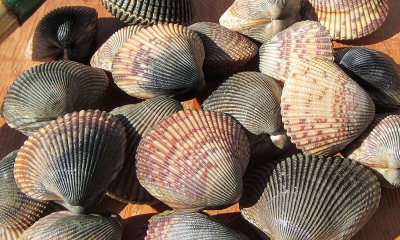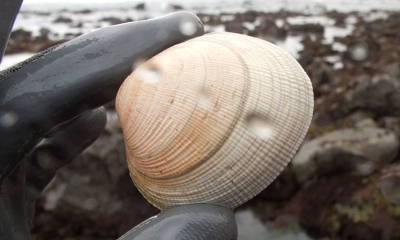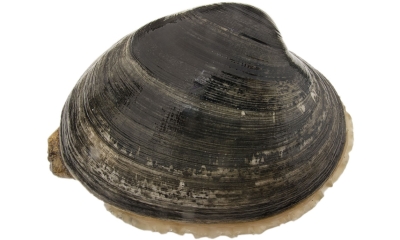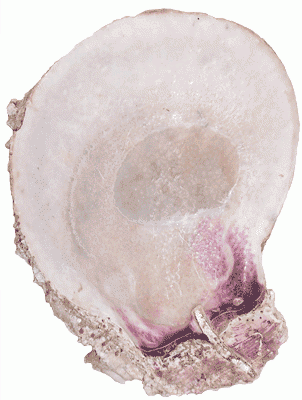
Clams

Types of Clams

Features: This clam has a long, narrow, thin shell with a smooth brown coating.
Habitat: Razor clams are found in stable, sandy, surf-swept beaches of the open coast and some coastal bays. Razor clams have the ability of digging up to a foot per minute and have been found more than four feet deep in the sand.
The 18 mile stretch of Clatsop beaches account for 90% of Oregon’s razor clam harvest. The razor clam population in this area is much denser than any other area in the state.
Other areas that also have razor clams include Indian Beach (Cannon Beach); Cannon Beach; Short Sands (North of Manzanita); Cape Meares Beach (Tillamook); Agate Beach (North of Newport); North Beach and South Beach (Newport); Waldport Beach; North Umpqua Spit (Winchester Bay); Bastendorff Beach and North Spit (Coos Bay); Whiskey Run (Bandon); and Meyers Creek Beach (Gold Beach).
Technique: The best clamming is during low tide (minus tides are the best) and when ocean swells are low as that is when clams will be nearer the surface. When a razor clam extends its neck near the surface of the beach it produces a distinct “show.” Shows are found most commonly by one of two methods: Looking for small round dimples in dry sand or pounding a shovel handle in receding surf.
Once you find a show, start digging either with a shovel or clam gun. Razor clams dig fast, so you must dig faster. Be careful reaching into the hole to retrieve your clam – they’re named razor clams for a reason. These clams have a very thin shell that can be easily broken when digging for them. This is why you are required to keep the first 15 clams you dig.
Learn more here before getting started clamming.
See Oregon Sport Fishing Regulations for information on the daily catch limits for bay clams.

Features: Identified by its prominent radiating ridges.
Habitat: Cockles are "hard shelled" clams. Their protective, stout shells and short siphons mean that they do not have to bury as deeply as other common bay clams. Good cockle beds will often have cockles right on top of the sand on a good tide. They prefer sandy areas with high salinity, but can be found at many types of tideflats.
Technique: The best clamming is during low/minus tides. Because these clams are so near the surface, you rake, rather than dig, for them. A four prong gardening rake is perfect for raking the wet sand near the water line. You’ll feel a “clunk” when you hit one. In softer sediment, you may also feel them under your boot. Feeling adventurous? Pull on your waders and rake in shallow pools or channels to find cockles.
Learn more here before getting started clamming.
See Oregon Sport Fishing Regulations for information on the daily catch limits for bay clams.

Features: Circular in shape and 1.5-2.5 inches across. Identified by concentric lines and radiating ridges. Longer lived and less abundant than cockles.
Habitat: High salinity areas of sand, mud, gravel, or rock. Harvest them in Tillamook, Netarts, Yaquina, and Coos bays.
Techniques: These clams can be found in rocky nearshore areas within 6 inches of the surface. Using a rake for these clams is the best harvest method.
Learn more here before getting started clamming.
See Oregon Sport Fishing Regulations for information on the daily catch limits for bay clams.

Features: Butter clams have oval and oblong shaped shells with heavy, thick valves and hinge. Their shells have fine concentric rings. When the shell is open a little, you can see the pale ruffled mantle reminiscent of a tuxedo. Like the gaper clam, they have their two siphons fused together into one "neck." Average adult size is 3-4 inches but can range up to 5 inches. Butter clams can live more than 20 years.
Habitat: Butter clams can be found in a wide variety of substrates but prefer sand and gravel/cobble beaches. They live approximately 6-12 inches deep and can be found in the mid-intertidal to subtidal zones. They are most often found in large estuarine systems, such as Tillamook, Yaquina, and Coos bays, and places with few rivers like Netarts Bay, because of their preference for higher salinity water.
Technique: Dig next to the show and not on top of it... shells break fairly easily and digging next to the show helps prevent hitting the shell with the shovel. Since clam siphons are not always directly vertical, many clammers prefer to use a wooden dowel to follow the siphon hole down.
Learn more here before getting started clamming.
See Oregon Sport Fishing Regulations for information on the daily catch limits for bay clams.

Features: Unlike gaper clams, softshell clams have no gape on their neck end. Softshell clams have a spoon like projection on the left valve, this feature is called a chondrophore.
Habitat: Brackish, muddy areas all along Oregon's coastline. Find softshells 12-18" depth.
Technique: Softshells can be harvested by digging with either a shovel or clam gun. As the name suggests, they have soft or thin shells which are easy to break. Although a clam with a broken shell is still good to eat, sharp edges of a broken shell can be very dangerous. Until you've refined your shoveling skills you may try very carefully grabbing them by hand once you dig near their depth.
Learn more here before getting started clamming.
See Oregon Sport Fishing Regulations for information on the daily catch limits for bay clams.

Features: Gaper clams have large "neck" housing the two siphons that protrude above the substrate surface when feeding. Protective leathery plates are found just below the siphon tips and feel rough to the touch. Gapers are unable to retract their neck entirely into the shell, producing a "gape" in the shell. It is common for algae to grow on their necks and gaper pea crabs to dwell inside the shell with the gaper clam.
Habitat: Gapers can be found in high salinity sandy and/or muddy areas in most of Oregon's larger estuaries. Tillamook, Netarts, Yaquina, and Coos are favorite bays of these trophy size clams. Be prepared to dig 1-2 feet to claim this prize.
Technique: Dig for gaper clams with a shovel. A shrimp gun can also be used to take some of the work out of digging. As you pump with the gun, water will be pulled into the hole and the sediment will become liquidy. They have a "show" (burrow hole) a bit larger than a quarter, making them easily identifiable to an experienced eye. You know it is a gaper if you test the hole with your finger and feel the siphon retract.
Learn more here before getting started clamming.
See Oregon Sport Fishing Regulations for information on the daily catch limits for bay clams.

Features: The purple varnish clam is named for the purple hue found inside the clam and the shiny varnish over the brown color outside the shell. It is oval in shape and is relatively flat with a prominent ligament near the hinge.
Habitat: These clams can be found in cobble to muddy substrate.
Technique: Purple varnish clams are found in very high densities. Limits are 72 a day.
Learn more here before getting started clamming.
See Oregon Sport Fishing Regulations for information on the daily catch limits for bay clams.

The rock scallop (Crassadoma gigantea) lives in the swift current shallows of Oregon's nearshore rocky reefs. Due to the coloration at its hinge, it is also known as the purple hinged scallop. These highly specialized scallops cement themselves to rocks, primarily at depths from 10 to 150 feet. They feed on microscopic plankton they filter from the water and reproduce via broadcast spawning. In order for spawning to be successful, they need to be close to one another. For this reason, it is best to harvest solitary rock scallops and minimize harvest pressure on dense aggregations which are more important to the population than those which are solitary.
Buttons, or the abductor muscle, keep scallops held together tight and is a highly prized delicacy. Rock scallops are harvested by divers along the rocky high current areas of Oregon's nearshore.
In addition to a Shellfish License, a free Scallop Harvest Permit is required to harvest rock scallops. These permits can be obtained at Astoria, Newport or Charleston ODFW offices. Permits can also be issued by emailing your name, address and ODFW number to odfw.scallops@odfw.oregon.gov. If you can not pick one up at one of the offices, permit will be mailed to you; no electronic issuance is possible.
Harvest information must be filled out at time of landing (i.e., at beach for shore diving or on boat when offshore). The harvest card must be returned to get a permit the following year. Data from this harvest card allows fishery managers to understand trends in the fishery, guide research and regulations, and assure the safe continuation of this important sport fishery.
Scallops brought ashore must be whole and in a condition that size can be determined. Scallops must not be removed from their shell in the field, except when prepared for immediate consumption.


